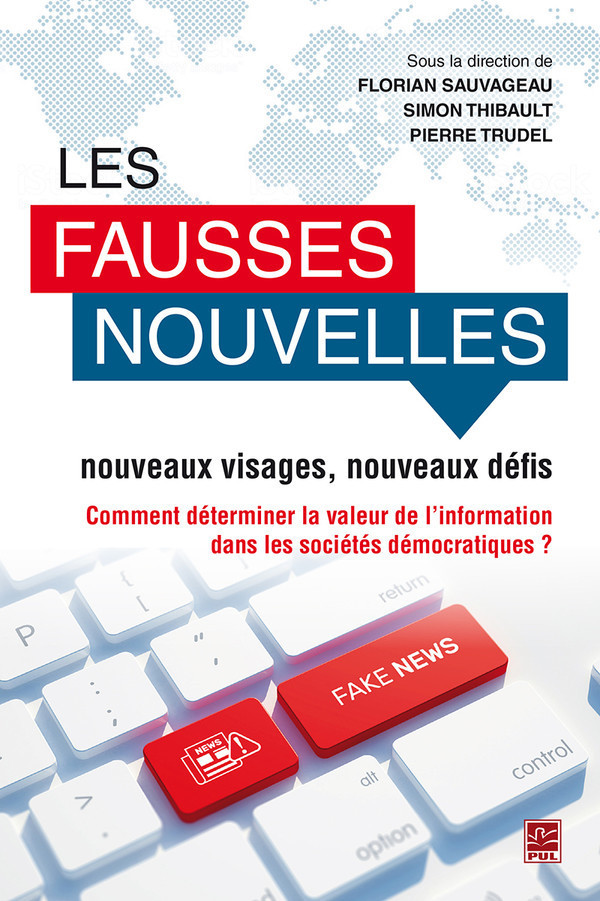 A new book on Fake News is published by the Presses de l’Université Laval (in French), edited by Florian Sauvageau and Simon Thibault. The book is intended for journalism audience and is a result of the October 2017 Workshop entitled “Les fausses nouvelles : le nouveau visage d’un vieux problème” [Fake News: A New Face of the Old Problem] in Montréal. The Workshop was organized by le Centre d’études sur les médias by the Laval University, Université de Montréal and UQAM. See the publisher’s page for the book introduction (in French).
A new book on Fake News is published by the Presses de l’Université Laval (in French), edited by Florian Sauvageau and Simon Thibault. The book is intended for journalism audience and is a result of the October 2017 Workshop entitled “Les fausses nouvelles : le nouveau visage d’un vieux problème” [Fake News: A New Face of the Old Problem] in Montréal. The Workshop was organized by le Centre d’études sur les médias by the Laval University, Université de Montréal and UQAM. See the publisher’s page for the book introduction (in French).
For this publication Victoria Rubin contributed a chapter on the state of automated methods for identifying “fakes”:
- Rubin, Victoria L. (In Press). “La détection des nouvelles trompeuses et fallacieuses dans les contenus en ligne” [or “Detecting Deceptive and Misleading News in Online Content”]. In Sauvageau, Florian, Thibault, Simon et Trudel, Pierre (eds.), Les fausses nouvelles : nouveaux visages, nouveaux défis. Québec : Presses de l’Université Laval.
The Chapter provides explanations for a general educated audience (like journalists and journalism students as well as avid news readers) and exemplifies some of the NLP and ML advances with R&D in our LiT.RL lab. Here is a 4-paragraph summary excerpt (in English) that will give you an idea for what the “Detecting Deceptive and Misleading News in Online Content” Chapter is about:
Conclusion and Future Research
“This chapter overviews language-analytical technologies that are promising in identification of varieties of deception, or “fakes” in digital news and other computer-mediated content online. Currently, to the best of my knowledge, there is no perfect automated solution to the “fake news problem”, though many research and industry labs across the globe are looking for one. The scale of propagation of “fake news” and their reach may be unprecedented as of 2018, but fundamentally we are still dealing with the human inability to distinguish lies from truths. Conceptually, it is difficult to imagine engineering such a “one-stop” solution, just as it would be difficult to cure all ailments with the same remedy. Techniques for identification have to differ from one variety of deceptive or misleading information to another. As explicitly exemplified by the work of my lab, if approached as a multi-part solution, current text analytics (using NLP and ML) offers partial modular detection solutions.
We currently advocate a multi-part holistic solution, expressed through a suite of state-of-the-art assistive tools, currently under development as the LiT.RL News Verification Browser. We target identification of potential disinformation one by one: outright deception, satire, or clickbait. Automated detection success rates with binary classification algorithms vary from preliminary state-of-the-art accuracies for deception detection (in mid-60% to mid-70%), to more sure predictions for satire (mid-80% to 90%) and clickbait detection (mid-90%).
Automated detection of deceptive messages based on linguistic cues (what is said and how) is only one part of the solution. The overall goal of this research is for systems to provide assistance to human judgements with alerts or highlights of suspicious instances that exhibit the predicted patterns. It is ultimately about supporting people in making conscious choices to ignore, delete or otherwise disengage from the disinformation cycle.
Further research is needed to stay abreast of the newer forms of dark creativity in digital deception. In addition, I call for more training in critical thinking and a proactive inclusion of recognizable patterns of various “fakes” as part of information literacy curricula at different educational levels and venues. The eventual solution for the society is in more refined awareness and more vigorous regulation of the digital media propagating “fakes”. Yet, the ultimate decision – about whether a particular online news is deceptive or misleading in any way – rests within the individual human mind.”
The full text pre-print of the Rubin’s Chapter will be available (in English) via Scholarship@Western University’s Open Access Repository.
A YouTube Video of the Rubin’s related speech in the Workshop can be found here as well.
